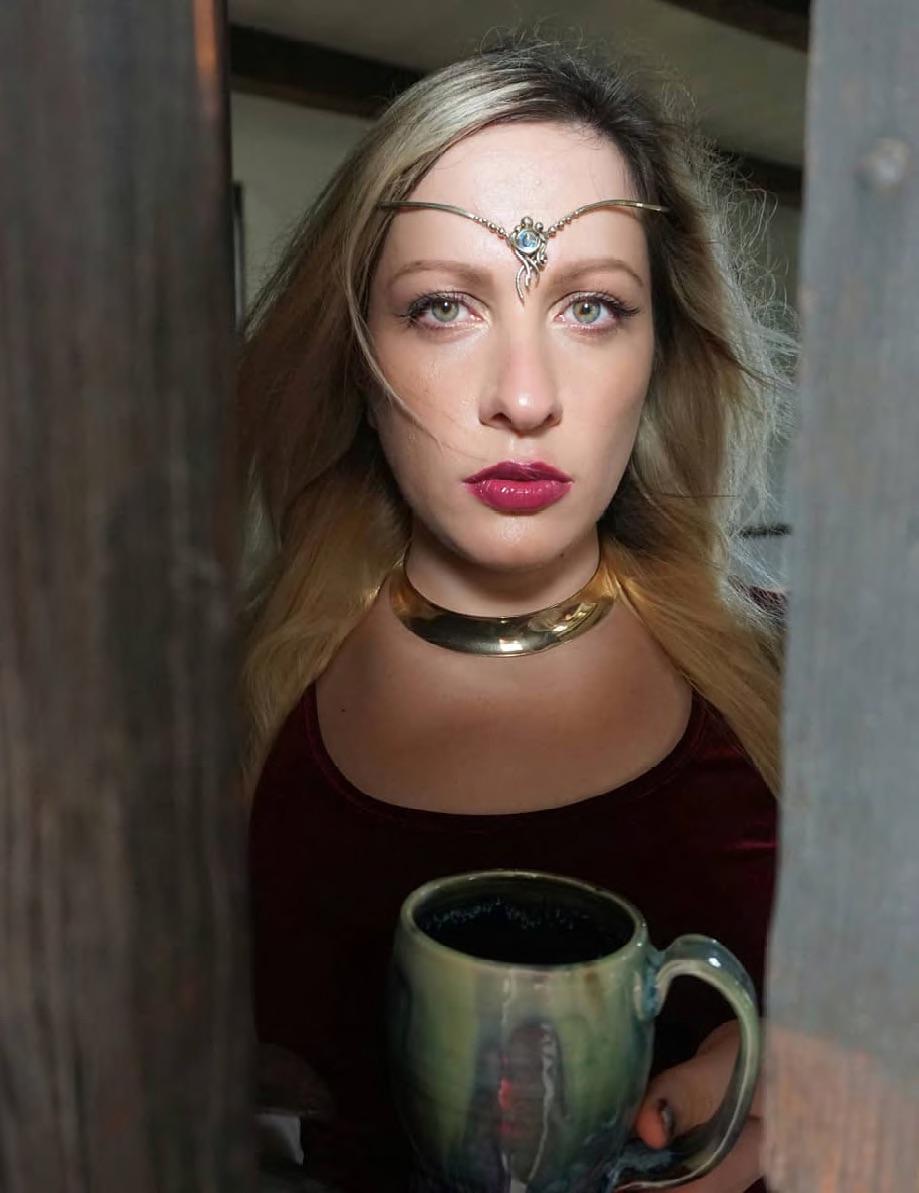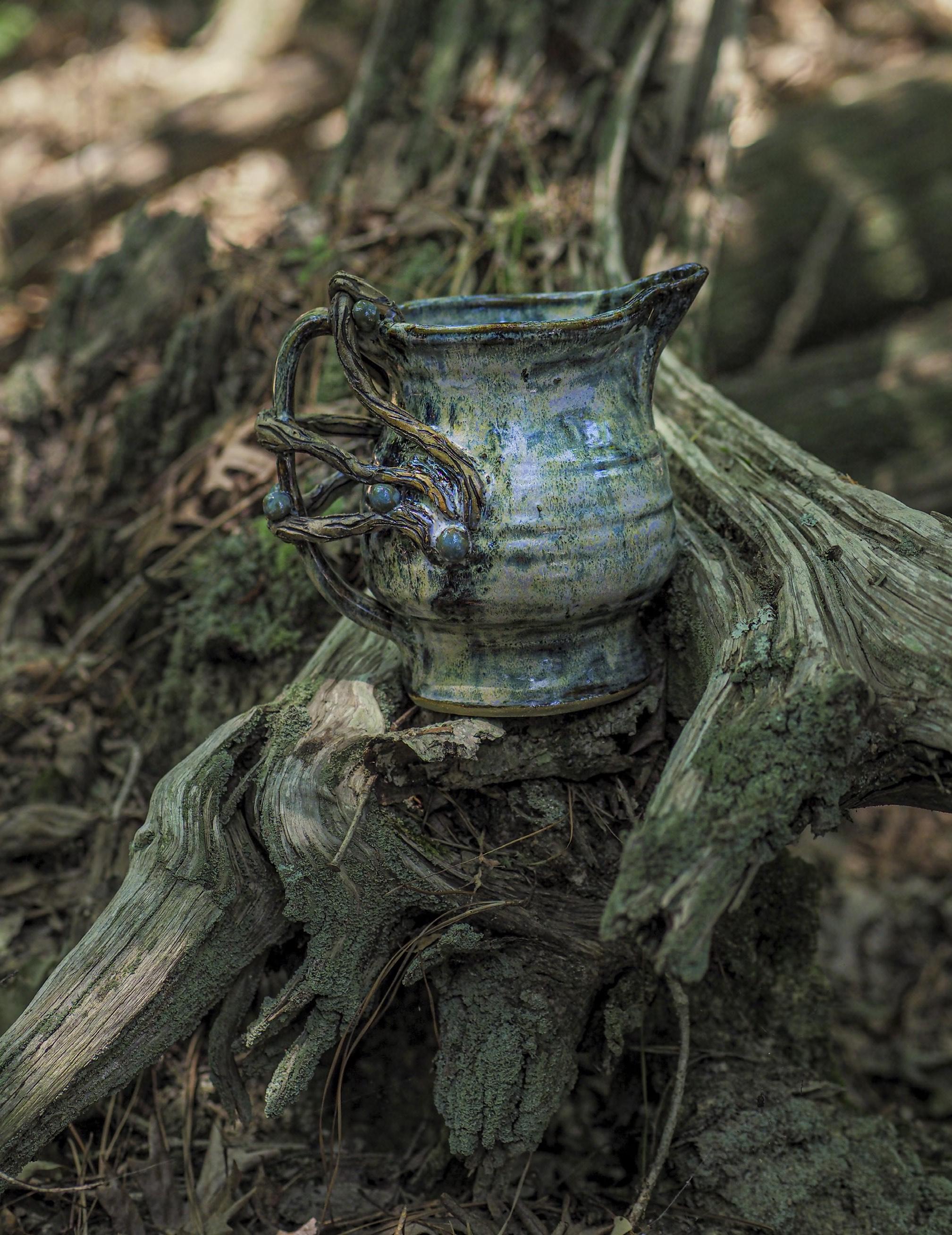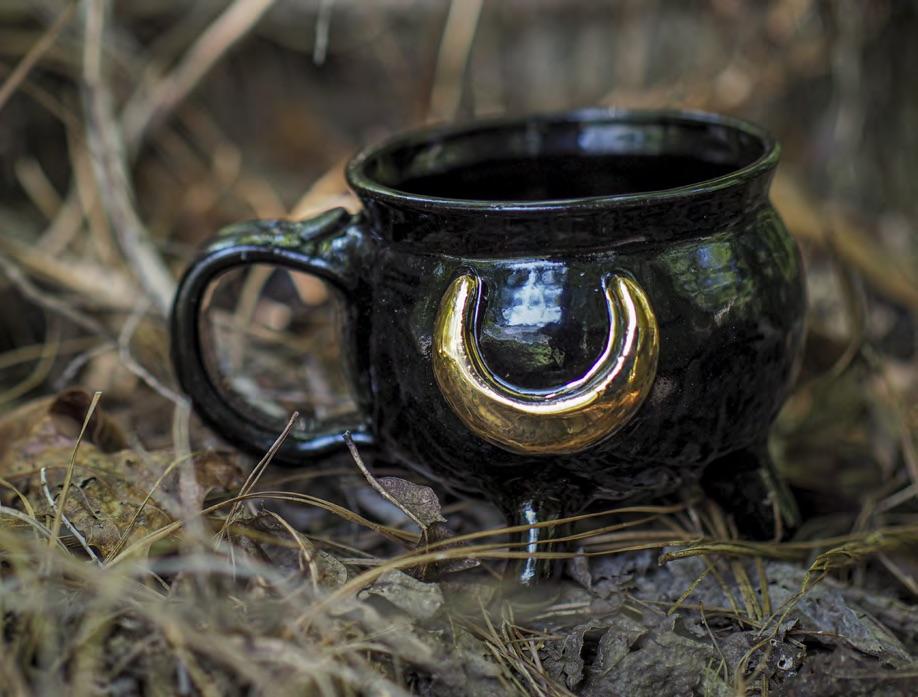Photography by Steve Parke
It’s about legend and myth. Intention. Nature and the wild—within as well as without. The four elements and spirituality, healing and metaphysics. Ritual.
 The power found in connection as well as in solitude. But perhaps more than anything else, Rachael Platt’s remarkable ceramics denote enchantment. Witchery of a kind, even. Which shouldn’t be a surprise to anyone who has cradled one of her carefully crafted mugs or mini cauldrons in their hands, perhaps finding, as they slowly sip a bit of morning coffee, their mood inexplicably gladdened. Those who have fallen under the spell of Platt’s bowls and cups, chalices and cauldrons, have learned that her pottery is unquestionably far more than the sum of its simple parts.
The power found in connection as well as in solitude. But perhaps more than anything else, Rachael Platt’s remarkable ceramics denote enchantment. Witchery of a kind, even. Which shouldn’t be a surprise to anyone who has cradled one of her carefully crafted mugs or mini cauldrons in their hands, perhaps finding, as they slowly sip a bit of morning coffee, their mood inexplicably gladdened. Those who have fallen under the spell of Platt’s bowls and cups, chalices and cauldrons, have learned that her pottery is unquestionably far more than the sum of its simple parts.
This is precisely what Platt intended when she founded her business, One:Eleven Pottery, so named for what she calls her “personal number,” one that she says has shown up throughout her life and, according to numerology, is the number of manifestation. “When you see it, you need to stop and reflect about your thoughts and intentions,” Platt says. “Thoughts are very powerful, and through them you have the power within yourself to manifest your intentions. You can create your own reality. Everyone holds the power, it’s just a matter of acknowledging it. And through my intention in my work I hope to remind people that they are very powerful. That’s really the essence of magic to me.”
If Platt is hoping to remind people of their power, in a larger sense her intention is that her ceramics might also provoke a kind of healing. “I try to manifest this in a variety of ways,” she says. “One, first and foremost, is the connection between maker and owner. I make my wares with a lot of love and attention. I have some secrets, but in general I do intentionally imbue them with a sense of love and care that I hope is very evident when a client holds their piece in hand. A vessel of goodness, in a sense! Second, the metaphysical properties within crystals inspire me and my glazes.

By naming my glazes after these sacred earth objects, I hope for their awesome attributes to take part in my work and their eventual ritual use.” By “ritual” Platt is referring to more mundane (if comforting) ceremonies—a warm cup of tea on a cold winter night, for example—as well as fantastic. But, inspired by the stones she has been collecting since childhood, the names of the glazes Platt concocts herself are dazzlingly mystical: Arcane Nephrite, Runic Moonstone, Amethyst Sacrament, Mystick Fire Opal, Ritual Carnelian, Chalcedony Star, Mage’s Sunset Sodalite, Sorcerer’s Ammolite, and Rose Quartz Anima.
Platt was raised in St. Mary’s County, Maryland, which sits in the far southern section of the state, surrounded by the Chesapeake Bay and the Potomac and Patuxent rivers. She grew up playing in mud puddles and dabbled in painting with acrylics in high school. But intent on becoming a teacher, Platt never seriously considered art as a potential occupation. It wasn’t until college— she graduated from Towson University in 2014—that she discovered a career in education was a terrible fit but a career in ceramics suited her superbly.

“Because I’m an introvert, energy is very precious to me,” Platt says, “And student teaching just took that energy from me. It’s interesting—I had my first ceramics class at the same time that I was losing my faith in becoming a teacher, and it was just night and day. I would spend hours in that studio. It was healing me and making that semester okay, because I was really struggling. I would be in the studio until four o’clock in the morning. It was as if time was suspended when I was working.”
Platt finds inspiration—itself a bit of magic—in a beautifully wide-ranging variety of sources, from J.R.R. Tolkien’s wonder-infused depiction of nature to the St. Mary’s legend of Moll Dyer, who was denounced as a witch and froze to death after being driven from her home by townspeople on a brutally frigid night. Other influences include the folklore of Western European, Celtic, and Greek cultures, as well as ancient Egyptian legends.
“There are two distinct but interconnected ways I think about my work,” Platt says. “On one hand, my focus is closely aligned with the forest and wilderness as a space and the various ways cultures have interpreted it: its deities, its spirits, and its use as a kind of gateway to the hidden places within the world and within ourselves. And in those forests, we find dryads, talking trees, animal spirits, dark and malevolent fae—the whole gamut, both historical and fantastic! I also look to trees on an individual level, as sacred icons and symbols of life and sentinels or protectors of the sacred.“But I have also found,” Platt adds, “a great deal of strength and power in thinking about goddesses in various world traditions. The notions of feminine power, the connection to ‘earth mothers’ and deities of fertility, are part of a long tradition for most cultures and are explored with dizzying variation depending on where you look. Wise women (often labeled as ‘witches’) are part of this tradition—a way for women to tap into the essential power within themselves and the world. I’ve been inspired by Brigid, a figure in Celtic mythology. She’s associated with the dawn, poetry, healing, fertility, and smithing; I also deeply associate with Hecate and Artemis within the Greek tradition, particularly as figures of ambiguous placement on the traditional good-evil axis.”

For Platt, part of the power and magic of pottery comes from the elemental process through which it’s created. Earth gives pottery form; water is used to create its shape; air dries it; and fire, which can be the most destructive element of all, merges the other elements, transforming them, as she notes on her website, “into something everlasting and unified.”
That something, Platt has learned, if infused with love and good intention, if crafted with a wide-open heart, can mend not only the one who eventually possesses it but also the one who created it. “I spend all my day very quiet and not speaking a word, almost like a monk, just very focused on my work,” Platt says. “I do find my process very ritualistic, and I sink my own personal and spiritual beliefs into it. In a physical sense, I do light incense every time I load a kiln. I like to light tons of candles in the studio if I’m up late into the night. The practice itself is meditative. What I’m most intent on is not the form I’m making, or the glaze that I’ll put on a fired piece, but instead the essence we’ve talked about. Pottery saved my life back in the day. It’s very, very sacred to me, and I think I continue to do it as part of my own healing and spiritual awareness.”
To see more of Platt’s work, visit oneelevenpottery.com.


































